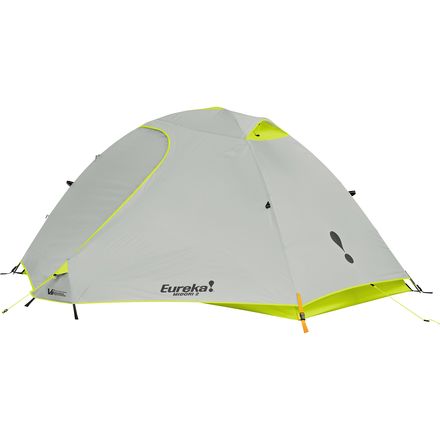Last year, tent-maker Eureka made a splash with a well designed new line of backpacking shelters in the form of the Midori 2 and 3. Those tents were lauded for being lightweight and affordable while still offering plenty of features that campers and backpackers really appreciate. This year they’re bringing that same sensibility to the new Eureka Midori Solo, which as the name implies is a lightweight tent built for one.
The Midori Solo has inherited a number of key features from its older, larger siblings that make it an attractive option for anyone looking for a single person tent for their excursions into the backcountry. For starters, I was impressed with how easy it is to set up, even on my first go. It took less than ten minutes to take the tent out of its included bag, assemble it and move inside. Considering the tent is designed for the solo hiker, that ease of set-up is much appreciated.
I was also impressed with the level of ventilation on the Solo. Here in Texas, we’re just now starting to cool off from the summer heat and the evenings have continued to be relatively warm. Rain has been at a premium as well, which meant I was able to camp without the rain fly without any issues. Even on warmer nights however, I was comfortable inside the tent with jut a light sleeping bag liner.
One of the most important aspects of any solo tent is how much it weighs, after all you won’t be able to split the weight across multiple backpackers on a solo excursion. Eureka has delivered a product that performs relatively well in this aspect, particularly considering the tent’s price tag. The Midori Solo tips the scales at 3 pounds, 9 ounces, which is hardly svelte but not especially hefty either. Make no mistake, there are solo tents that weigh considerably less than this one, but they’ll also lighten your wallet too.
Inside, the Midori Solo provides a solid amount a room for a single person although things get a bit tight if you bring too much gear inside. When secured into place, the rain fly provides a secure place for hikers to stash their gear to keep it protected from the elements. Inside their are a couple of gear pockets for keeping a few small items close at hand such as a headlamp or a multitool. A gear loft across the ceiling provides even more internal storage.
With the fly in place, this is a tent that is rated for three-seasons, making it versatile for just about any outdoor adventure save winter camping. As mentioned, we haven’t had much rain in my area, so I can’t comment on how well the Midori Solo performs in wet conditions. But if it maintains the same level of performance of the Midori 2 and 3 however, it should do well in adverse conditions.
On more than one occasion in this review I’ve indicated that Eureka has delivered a great tent at an affordable price. The Midori Solo will sell for just $129.99 when it hits gear shops in January of 2014. That’s a great price for a solo tent of this quality and relatively light weight. If you’re in the market for a single-person tent for your future excursions, without breaking the bank, this is a tent that I think you’ll be very happy with.
(Note: The photo in his story is of the Midori 2. I haven’t been able to find a solid image of the Solo yet and I didn’t carry a camera with me when I went camping with this tent. While the Solo is smaller and more narrow, the image of the Midori 2 does give you an indication of what the Solo looks like as well.)
- Gear Review: The Xero Scrambler Mid is an Ultralight Hiking Shoe for Spring - March 1, 2023
- Gear Review: Yeti Roadie 48 Wheeled Cooler - August 18, 2022
- Kristin Harila Continues Pursuit of 8000-Meter Speed Record - August 16, 2022

One of the first things that I did as I put together a bikepacking system was to see how the equipment worked in cold weather. Using a Klymit V2 sleeping pad and an Outdoor Essentials 20 degree bag, I spent 2 nights out in 20 degree weather and slept comfortably. Although not considered a 4 season tent, with the proper gear on the inside, this tent can be used in cold weather.
There was a lot of frozen condensation on the inside in the morning, but that is to be expected.
THANKS